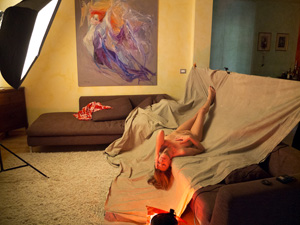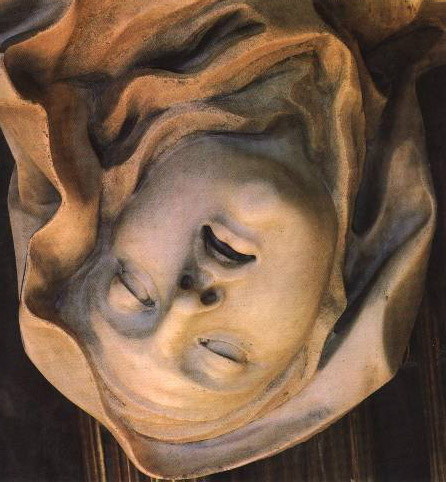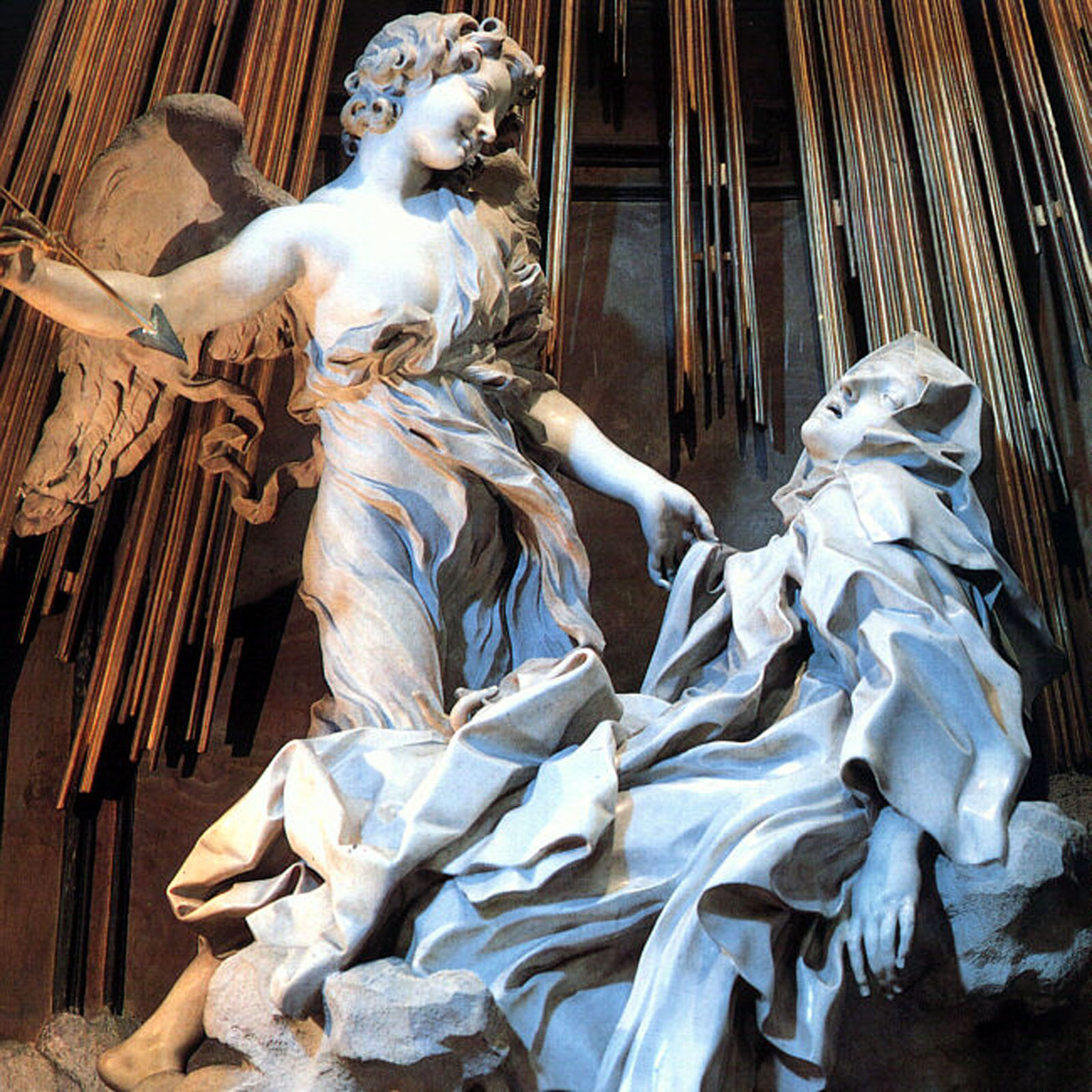Ecstasy
Sometimes when I do a picture it is simply because I admire a work of art so much I just have to take it on myself as a sort of homage to the original; but I do wonder if people will say, ‘so what?’ Perhaps this is one of them. It has neither any particular note of irony nor does it re-interpret the original. In fact if the Bernini sculpture is a work of genius in its ambiguity, my version is, well…… fairly straightforward, almost a reductio ad absurdum.
It did not take long to shoot and involved a very simple two light set up: soft key light and a flash head on the floor with a red gel. I used the modelling light only, no flash for low depth of field, 85mm f 1.8 lens wide open. As you can see the set was the model’s living room.
I am passionate about Bernini’s genius (this is my second homage, the first was Daphne), so here follows some background about one of his greatest works. The sculpure shown here is only part of a complex whole that includes the commisioner, Cardinal Cornaro and his family looking on like Statler and Waldorf from a theatrical box. It is to be found in the church of Santa Maria della Vittoria, not 10 minutes walk from the railway station, so I recommend a brief walk to admire one of the most remarkable sculptures of any age – absolutely free. If you know very religious person or better still a catholic priest, bring them along, it would be interesting to observe their reaction.

Saint Teresa detail
Bernini managed to ingratiate himself into the courts of a succession of popes and despite the odd mishap such as one of his buildings collapsing, the sodomising of a 16 year old boy and the disfiguring of his mistress Costanza with a razor, his genius was such that he never permanently lost favour.

Gian Lorenzo Bernini, “Ecstasy of Saint Teresa”
He was vicious with his nearest, vengeful to his dearest, spiteful and slanderous towards his rivals. But he had his good side, he was a vegetarian living mainly on fruit and he was the greatest sculptor of the Baroque age.
His genius was to make marble lighter than air and flesh appear soft to the touch. The open mouth, the half open eyes are unique to Bernini.
Santa Teresa described her rapture thus:
“……In his hands I saw a large golden spear and at its iron tip there seemed to be a point of fire. I felt as if he plunged this into my heart several times so that it penetrated all the way to my entrails. When he drew it out he seemed to draw them out with it and left me totally inflamed with a great love for God. The pain was so severe that it made me moan several times. The sweetness of this intense pain is so extreme that there is no wanting it to end and the soul is satisfied with nothing less than God. The pain is not physical but spiritual even though the body has a share in it – in fact a large share in it.”
No doubt the ambiguity in Santa Teresa’s account appealed to Bernini as much as the ambiguity of his statue appeals to us. Controversial since it was unveiled it nevertheless is an expression of ecstasy what ever the cause, divine or profane. As the Chevalier de Brosses, laconically remarked while passing through Rome, “Well, if that’s divine love, I know all about it.”


Ciao Patrick,
Innanzitutto complimenti per la tua nuova opera: mi piace anche il tono low. Però qui al mio monitor l’immagine sembra avere un rosso (il rosso delle labbra) fluorescente ad alta visibilità come le tute dei lavoratori Anas. Boh! Forse il mio monitor ha problemi.
Io penso che s. Teresa d’Avila abbia vissuto la sua esperienza d’Amore Sacro con emozioni che non hanno un riscontro nelle esperienze umane. L’ambiguità nasce dal linguaggio, la cui semantica umana attribuisce al nostro immaginario sensazioni ed emozioni conosciuti a tutti noi.
Una veggente di nome Maria Valtorta scrisse di s. Francesco quando ricevette le stimmate:”si ode un suono di Paradiso, Francesco ride, e piange, e splende nella sua gioia estatica, l’angelo Serafino apre le due ali che stanno nel mezzo della croce […] ed appare la Croce. La mia vista, dice la veggente, e quella di Francesco, ne hanno sofferenza di gioia per il vivo abbaglio […] Francesco è quasi riverso, tanto è piegato indietro a braccia completamente aperte sotto il suo Dio Crocifisso […] le lacrime che scendono dal suo volto come a temperare l’umana arsura della mistica fiamma, splendono come rivi di diamante sulle guance magre”. Questa descrizione sembra un amplesso, vero Patrick.
La visione prosegue, ma io intendo soffermarmi su come appare il santo: piange, ride, gioisce e soffre dalla gioia.
Sono parole che nel nostro immaginario evocano sensazioni a noi note. Ma realmente quale sensazione abbiano provato sia s.Teresa sia s.Francesco, non ci è dato sapere.
Ed io credo che sia giusto così che noi non possiamo saperlo perché lo Sposo Divino ha un rapporto singolare ed unico con i suoi amati.
Quindi l’espressione di Chevalier de Brosses è presuntuosa e misera nella sua ignoranza.
Un caro saluto,
P.
P.s.: Scritti di Maria Valtorta
http://www.mariavaltorta.com/
http://www.scrittivaltorta.altervista.org/per_volume.htm
Ah, how I love the Bernini! And your photo echoes it beautifully. For me the red is what makes your image so memorable. This is ecstasy visualised in colour.
Do you know Simon Schama’s fascinating documentary The Power Of Art? I highly recommend it. He has an episode on the Bernini statue in which he leaves no doubt the relationship between spiritual and physical ecstasy. The series also covers Caravaggio, Rembrandt, Turner and Rothko (plus some others that I forget). It’s a tour de force of art appreciation. Check it out.
One day I will get myself over to Rome to see the original Bernini, and then on to Tuscany to see some of your originals!
rgds
Tom
thanks Tom for the comment. I’ll buy the Schama programme I think because I’m sure my daughter will like the series too when she’s a bit older. At the moment she keeps quoting me the most gruesome bits of ‘Horrible History’ to me. I can’t wait for her to get into art!
See you in Rome